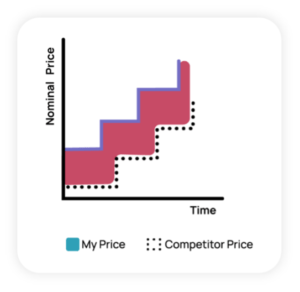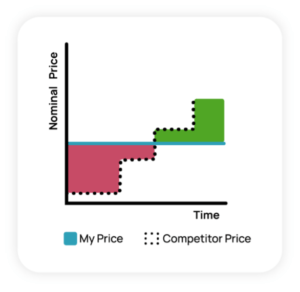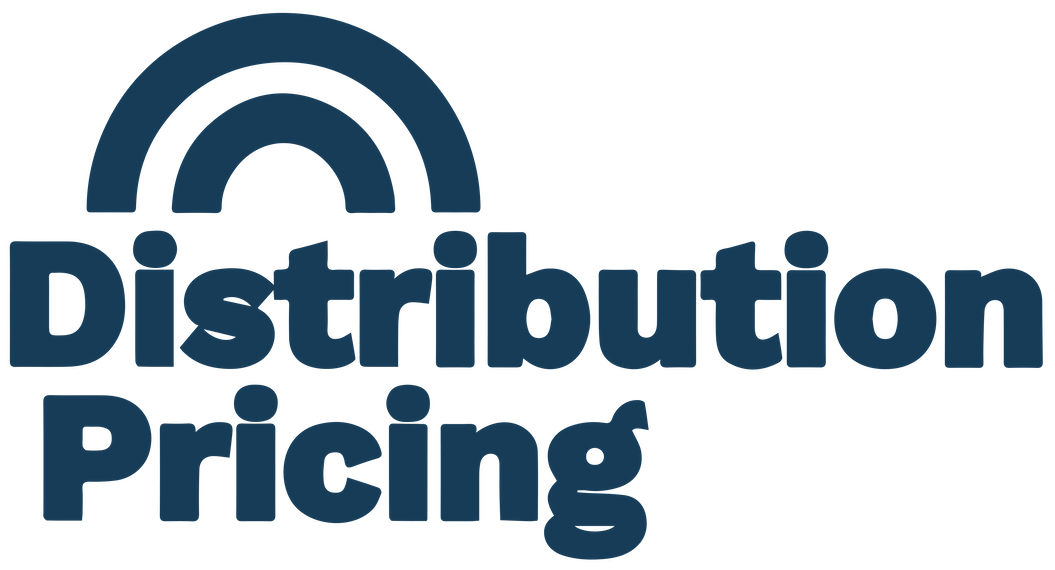Your passion for distribution pricing is what fuels our mission to deliver the most valuable and actionable insights to your inbox.

Tips for Understanding Your Competitors’ Prices and Staying Ahead of Your Competition
In the distribution industry, competitive price intelligence can be a great source of insight. Understanding the pricing strategies of competitors can provide invaluable information about the market and how to best position one’s offerings. It is important to explore how competitive price scenarios can be used to inform decisions such as product positioning, value added services, price optimization, purchasing strategies and promotional offers.
Your competitor’s pricing can indicate potential opportunities or threats posed by competitors. Understanding their competitive positioning involves looking at their prices, products, services and availability. It also requires understanding how customer needs and behavior might influence their purchasing decisions. Additionally, it may be necessary to assess how competitors are responding to the changing market conditions.
Once the appropriate data is collected, distributors can evaluate their pricing decisions and adjust accordingly. This could include changes in promotional offers, discounts or other forms of price adjustments. It could indicate new operational or purchasing adjustments. It might even be time to initiate some new vendor negotiations about your pricing and rebate offers. It is important to keep in mind that different scenarios may require different pricing strategies, and each must be evaluated on its own merits.
By leveraging competitive price scenarios, businesses can gain valuable insights into the market and how to best position themselves for success. Through careful analysis, businesses can develop effective pricing strategies that maximize profits while still providing value to customers. In addition, understanding competitive dynamics and responding appropriately can lead to more efficient operations and better customer satisfaction. Ultimately, competitive price scenarios can be an invaluable tool in helping businesses stay competitive and successful.
We asked Daniel Cakora, Business Consultant at Vendavo, a global market leader in B2B price management and commercial excellence solutions, to provide some of his insights on competitive pricing scenarios.
Scenario 1: My Price Increases and My Competitor Follows Suit

The first scenario Cakora referenced involves an initial price increase and a competitive increase closely thereafter.
“If the price of your company’s products goes up and its competitor follows, it is a sign that your company is a pricing leader in its market,” said Cakora.
This scenario indicates that the company has the potential to positively affect profitability by leading with other price increases. This allows your company to have more control over pricing decisions, enabling you to maximize profits while still providing competitive prices. When your price leadership is driven by solid price optimization analysis, it allows you to better respond to customer needs and adjust pricing accordingly to maximize profits. According to Cakora, this is especially important in highly competitive markets where customers expect to get the best price possible. Overall, leading in pricing decisions through a higher initial price can lead to greater profits and a more secure market position.
Scenario 2: My Price Remains Steady and My Competitor’s Price Increases

If your price remains steady and your competitor’s price increases, a few situations might be true, according to Cakora.
“This could signal solid customer demand or could indicate inflationary costs. If customer demand is driving the price increase, then it implies that buyers are willing to pay more for a product and may be less sensitive to price. Of course, you might also simply be pursuing a lower pricing strategy to gain market share, such as a loss leader strategy,” said Cakora.
If you’re a distributor using price optimization solutions, you may feel confident in your pricing strategy. Your competitor may not be using special tools to help them decide how much to charge for their product. It could mean that their price increase was not planned carefully.
“Remember, just because a competitor changes their price, it doesn’t mean they’re taking the right path,” said Cakora.
When considering the cost of products in comparison to a competitors’ prices, it is important to consider the effectiveness of managing your own costs. If a competitor’s price is higher than yours, it may be an indication that you have done a better job at managing your replacement costs and the overall costs of operation, pick-pack-ship and storage. This can be an advantage for distributors as it can lead to higher profitability and better margins. Additionally, when prices are managed effectively, customers may be more inclined to purchase your product or service as they will have access to a lower price point.
By managing costs efficiently, businesses can remain competitive in the marketplace and benefit from the cost savings. This underscores the importance of using price optimization solutions because there is always a balance to strike between the profit driven by better purchasing and operations and the profit driven by optimizing your pricing to appropriate market levels.
On the other hand, if your competitor’s costs are increasing, they may be forced to increase prices in response. If this is the case, then it’s important to work with your suppliers and purchasing team to determine where potential efficiencies have been gained and could be developed in other product lines.
According to Cakora, if a competitor’s price is higher than yours, it could also mean that they have added more value to their overall offering, which justifies the higher price. This could be for several reasons. It could be due to the perceived quality of the product or service. Are they offering new value adds, better packaging, unique shipping offerings or something else? New value-added services may allow them to command a higher price due. Moreover, if a competitor has better brand recognition or higher customer loyalty, then this could also lead to them charging more for their goods and services.
Finally, if the increase in price does not appear to be based on either consumer demand or cost increases, you need to dig a little deeper to discover why your competitor is using a different pricing strategy than you.
“My advice to anyone who finds themselves using a different pricing strategy than their competitor is to dig a little deeper and potentially reconsider your own pricing strategy to ensure it is still in line with the market. Run back through your price optimization analysis and look to see if there are some unusual price matrix issues that just need to be dealt with mechanically in your ERP system,” said Cakora.
Scenario 3: My Price Remains Steady or Rising but My Competitor Is Lowering Their Price
Next, we asked Cakora what companies should do if their price is steady or rising but their competitor is steadily lowering their price.
“This scenario is the opposite of when your competition gets more expensive. So, you want to flip the questions you asked above upside down and apply them to your own business,” said Cakora.
It could mean that customer demand is driving the price increases and buyers are less sensitive to the price. Maybe you’ve been a little bit late on your analysis around this product line. It could point to your competitor’s cost structure being better than yours.
Alternatively, it could indicate that you are not providing enough value-add to justify a higher price point. It might be time to do some competitive shopping around the value adds your competitor is offering. It may also be necessary to implement other strategies as well, such as improving customer service, enhancing the value of product or service offerings, or increasing marketing efforts.
If your price is steady or rising while they are lower their prices, it could point to a new competitor or product brand is entering the market and attempting to gain market share. A manufacturer may be offering more attractive rebate incentives, or they may be offering a lower priced product that is forcing the entire category to price lower. In either case, it’s important for businesses to stay abreast of any changes in pricing and adjust their own prices accordingly if they want to remain competitive.
Other Scenarios
There are a few other competitive pricing scenarios not covered here. For more scenarios from Dan Cakora read, How to Collect, Analyze, and Visualize Competitive Price Data.
Competitive Price Analysis Isn’t Easy in Distribution
Determining how to price your products or services is a difficult task. While understanding your competitors’ pricing is critically important, it’s also only one element to consider in your strategic decision making. Solutions like Vendavo Pricepoint can help you boost your pricing agility and stay ahead of changing markets.
It is not always easy for a distributor to gain competitive intelligence around a competitor’s pricing. Such knowledge can be hard to come by, and the information that is available may not always be complete or up to date. Inaccurate data can lead to poor decision making, leaving a distributor at a disadvantage in the market.
Fortunately, there are ways for distributors to gain an advantage when it comes to pricing intelligence. By leveraging technology, distributors can access more accurate, timely pricing data and gain a better understanding of the competition. Automated price monitoring tools are especially beneficial in this regard, as they allow distributors to keep track of competitor prices in real time. This helps them make sure their own prices remain competitive and gives them insight into what strategies other players are using in the market. Additionally, price optimization tools can be used to increase profits and ensure maximum profitability by analyzing the market and setting the most advantageous prices.
______________________
About Dan Cakora
Dan Cakora is a Business Consultant at Vendavo and has worked in various aspects of pricing for more than 15 years. Dan started his career as a Field Economist responsible for helping to measure inflation for the federal government. Before joining the Vendavo team, Dan was a customer at a large, international B2B distributor. He has led pricing teams, developed pricing and sales enablement products, and has a passion for data visualization. Dan has an MBA from DePaul University and a BS in Economics from Purdue University.



